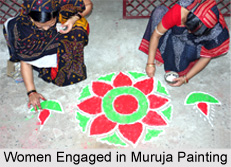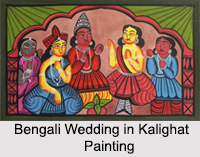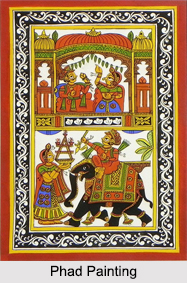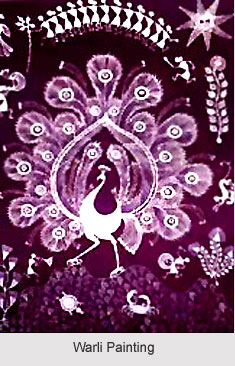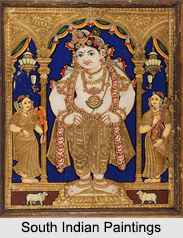 Painting Schools of South India have been instrumental in the fertilization of dexterous artists from the time of yore to the contemporary time. They are not only high in demand but even a highly sought after cache for the Eurocentric nations reflecting the art canvas of Southern India. Deccani School of Painting reminds one of Adil Shahi, Nizam Shahi and Qutub Shahi rulers who were the patrons in the development of Deccan School of painting. A lot of artists flourished during the rule of Ibrahim Adil Shah (II) (1580-1627), who was a great lover of painting. It is evident from the availability of numerous portraits of Ibrahim Adil Shah in different museums of the world. One of the finest portraits of him can be found in the Lalgarh Palace at Bikaner. The British Museum has another portrait of him, which was reproduced by Douglas Barrett and Basil Gray in `Painting of India`. These two portraits represent the typical characteristics of Deccan School of painting, like the `richness and mellowed grandeur`, which were set in a mysterious background.
Painting Schools of South India have been instrumental in the fertilization of dexterous artists from the time of yore to the contemporary time. They are not only high in demand but even a highly sought after cache for the Eurocentric nations reflecting the art canvas of Southern India. Deccani School of Painting reminds one of Adil Shahi, Nizam Shahi and Qutub Shahi rulers who were the patrons in the development of Deccan School of painting. A lot of artists flourished during the rule of Ibrahim Adil Shah (II) (1580-1627), who was a great lover of painting. It is evident from the availability of numerous portraits of Ibrahim Adil Shah in different museums of the world. One of the finest portraits of him can be found in the Lalgarh Palace at Bikaner. The British Museum has another portrait of him, which was reproduced by Douglas Barrett and Basil Gray in `Painting of India`. These two portraits represent the typical characteristics of Deccan School of painting, like the `richness and mellowed grandeur`, which were set in a mysterious background.
History of Painting Schools of South India
The earliest paintings in India date back to the Ajanta caves from second century B.C to 5th century A.D. The Sittavansal caves in South India are from the 7th century, trailed by the Ellora caves of the 8th to 11th centuries. In South India, the Brahadeswar temple has representations of paintings done in the Chola period of the 11th century. The earliest existing examples of miniature painting in Odisha emerge to go to the 17th century A.D. Some good cases of the paintings of this era are a court scene and four illustrated leaves of a manuscript of the Gita Govinda in the Asutosh Museum, Kolkata and a demonstrated palm-leaf manuscript of the Ramayana in the National Museum. An illustrated palm-leaf manuscript of the Bhagavata in the Asutosh Museum and a paper manuscript of the Gita Govinda in the National Museum are examples of the 18th century Odisha painting.
Types of Painting Schools of South India
There are different types of Painting Schools of South India and some of them are as follows:
The Deccani Painting: The Deccan school of Painting got inspiration from the Mughal School and evolved its own unique and very characteristic style. In the Prince of Wales Museum of Mumbai, the painting gallery has some typical examples of Deccan paintings, which have pale green, mineral-coloured backgrounds with figures placed squarely in the foreground. There are few other collections of Deccan paintings from Bundi, of the 18th century available here in this gallery, which deals with the theme of love. Another painting of the gallery depicts a lady looking in a Mirror (Bundi, 18th century). In this one, the artist has created a courtyard with a lush garden in the background and a pond of lotuses in the foreground that blossom in reflection of the glory of the young girl, or lover. One more painting of Bundi in 17th century depicts a `Nayika` in agony painting in another mood. The young lady is in agony, suffering the torment of separation from her lover. Ibrahim Adil Shah was shown as a musician in few other paintings available in the Naprstck Museum, Prague, and the Goenka Collection. Although the Mughal School of painting and the Deccan School of painting developed the naturalism due to European influence, yet there was a difference between the two. The Mughal school paintings were more dazzling in technique whereas the Bijapur or the Deccan School of painting represented more naturalism due to imaginative composition and poetic content.
Cheriyal Scroll Painting: Cheriyal Scroll Painting is a type of Nakashi art which are prosperous in the narrow patterns peculiar to the Telangana. The scrolls are painted in a description design depicting stories from Indian mythology and closely tied to the shorter stories from the Puranas and Epics. Earlier, these paintings were prevalent across Andhra, as also various other parts of the country.
Kalamkari: Kalamkari or qalamkari is a kind of hand-painted or block-printed cotton material, produced in Andhra Pradesh which is developed with the support of the Mughals and the Golconda sultanate. This style bloomed around temples and their aid and so had an roughly religious individuality - scrolls, temple hangings, chariot banners and the like, depicted deities and scenes taken from the Hindu epics - Ramayana, Mahabharata, Puranas and the mythological classics.
Kerala Mural Painting: Kerala mural paintings are the wall paintings depicting mythology and legends, which are drawn on the walls of temples and churches in South India, principally in Kerala. Ancient temples, churches and palaces in Kerala, South India, display an abounding tradition of mural paintings mostly dating back between the 9th to 12th centuries when this form of art enjoyed Royal aid.
Saura Painting: The Saura wall paintings are called italons or ikons which are drawn upon tribal myths and have ritualistic significance. Ikons make wide use of metaphorical icons which mirror the quotidian chores of the Sauras. People, horses, elephants, the sun and the moon and the tree of life are chronic motifs in these ikons. Ikons were originally painted on the walls of the Saura`s adobe huts.
Chola Paintings: Chola Paintings of South India have very high significance in the history of art. These paintings have great emotion in the faces, whether it is anger, compassion or any other expression. The murals of the Chola age bring out diverse emotions on many faces, a feature rarely seen in Indian art. The majestic temple of Brihadishvara in Thanjavur is an example of the great wealth and power of the Chola Empire. The best Chola paintings of South India are those found in the vimana of the temple. These paintings depict the scenes from the Shivapurana and also the elaborate pictures of domestic, public and palaces. These scenes are an excellent source of information about the Chola period. Most the paintings are massive and animated, which brings alive the greatness of the Lord who destroys evil and ensures peace. These paintings also depict a barely visible Dakshinamurthi (Shiva as God of knowledge) beneath a banyan tree on which monkeys are playing.
Nayaka Paintings: Nayaka Paintings of South India itself initiates an aura amidst the sea of South Indian paintings. These Nayaka paintings depict the scenes from the life of Rishabhadeva, the first Thirthankara of Vardhamana, of Krishna, the cousin of the Thirthankara, Neminatha as well as the life of Neminatha himself. These are all graphically portrayed in a long series with elaborate labels in Tamil language giving details of each painting which became the usual feature as such labels are seen in Chidambaram paintings and Tiruvalur etc.
Kolam Paintings: It is a form of painting that is drawn using rice powder/chalk/chalk powder/white rock powder and the often use of coloured powders in Tamil Nadu, Karnataka, Andhra Pradesh, and most parts of Kerala and some parts of Goa, Maharashtra, Indonesia, Malaysia, Thailand and a few other Asian countries. The kolam is a geometrical line drawing which is composed of curved loops, drawn around a grid pattern of dots. In South India, it is widely practised by female Hindu family members in front of their homes. Kolams are regionally known by different names in India, Raangolee in Maharashtra, Hase and Rangoli in Kannada in Karnataka, Muggulu in Andhra Pradesh, etc. Kolam thrives to be one of the popular schools of Southern Painting.
Pattachitra Painting: Pattachitra refers to the Classical painting of Odisha, in the eastern region of India. The tradition of Pattachitra is closely linked with the worship of Lord Jagannath. The subject matter of Patta Chitra is mostly mythological, religious stories and folk lore. Themes are chiefly on Lord Jagannath and Radha-Krishna, different "Vesas" of Jagannath, Balabhadra and Subhadra, temple activities, the ten incarnations of Vishnu basing on the `Gita Govinda` of Jayadev, Kama Kujara Naba Gunjara, Ramayana, Mahabharata.

